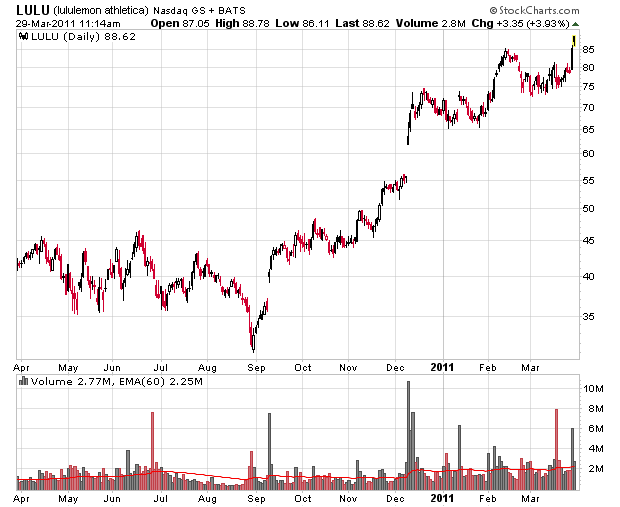People in and around the Vancouver area are probably quite aware of Lululemon, a marketing firm that sells retail apparel. Most people would consider them to be a retail apparel firm, but I would dispute this classification.
I have been watching this company since it went public, not because I ever intend to buy shares in the firm (or their clothing), but rather because it is a Vancouver-based business that has been insanely profitable and has done an incredible job permeating amongst my own age demographic.
Although I have very little intuition about fashion, I have studied the industry extensively and currently have some money where my mouth is in the form of a stake in corporate debt of Limited Brands (one major holding they own is the branding to Victoria’s Secret).
This morning, Lululemon reported their first fiscal quarter results. While I am less concerned about them beating or missing analyst estimates (they exceeded them) my focus is on their gross margins – 54% for this year’s quarterly result. This is a high gross margin for an ordinary clothing manufacturer, so they are adding much value on the marketing side and thus having their customers pay more for products that otherwise would cost the same to make.
Gildan Activewear, for example, has a gross profit of around 28% in their last quarter.
If you look at other firms to benchmark Lulu with (of which I will use Limited Brands, Abercrombie & Fitch and Nike) – Limited’s after-Christmas quarter reported gross margin of 36% (which includes “buying and occupancy” costs), while Abercrombie’s gross margin was 63% (strictly on “cost of goods sold”, not including store and distribution expenses), and Nike’s is 47% (albeit for the Christmas quarter, but their yearly results are comparable to this). If you were able to drill into the numbers and make them on an equivalent basis (which is not very easy to do when mining the details of the company’s detailed quarterly reports that they externally report), the profitability of Lululemon is not that much higher than equivalent (i.e. “high-end”) and established US corporations.
So looking at a relative valuation basis, you now have the following (not factoring in Lulu’s recent quarter):
LULU – Market cap $2.8 billion, TTM revenues $453M, net income $58M; (cash: $160M, debt: $0)
LTD – Market cap $8.0 billion, TTM revenues $8.84B, net income $558M; (cash: $1.7B, debt: $2.8B)
ANF – Market cap $3.1 billion, TTM revenues $3.01B, net income $90M; (cash: $633M, debt: $71M)
NKE – Market cap $34.8 billion, TTM revenues $18.65B, net income $1.73B; (cash: $4.0B, debt: $0.6B)
This very brief comparison gives me the belief that Lululemon is being valued as a marketing company (like Nike) rather than an “high-end retail” apparel company (like Limited and Abercrombie). It is also much, much differently valued than a “commodity clothing” firm like Gildan (which does not have a direct retail presence).
The most cursory glance at the financials would lead one to believe that if you were to believe that LULU was a “buy” at the moment, they would have to grow, considerably, into their valuation even to make it comparable to Nike’s valuation level. Assuming a “steady state” valuation of 20 times earnings and/or 2 times sales, you would have to extrapolate Lulu growing their top line at 30% a year for roughly 5 years with the share value being roughly the same as it is now.
Even though in the last quarterly result they grew their top line 70% over the previous year, it is very difficult to swallow a company’s shares thinking that they have an implicit requirement to grow their sales from $450M/year into $1.4 billion just to cut even. Will they do it? Who knows. But the level of baked growth makes the stock look very risky for the reward offered – if they have one misstep, they will see a 2008-style haircut. It won’t be nearly as bad as the 90% cut from the 2007 highs, but it will be considerable.
